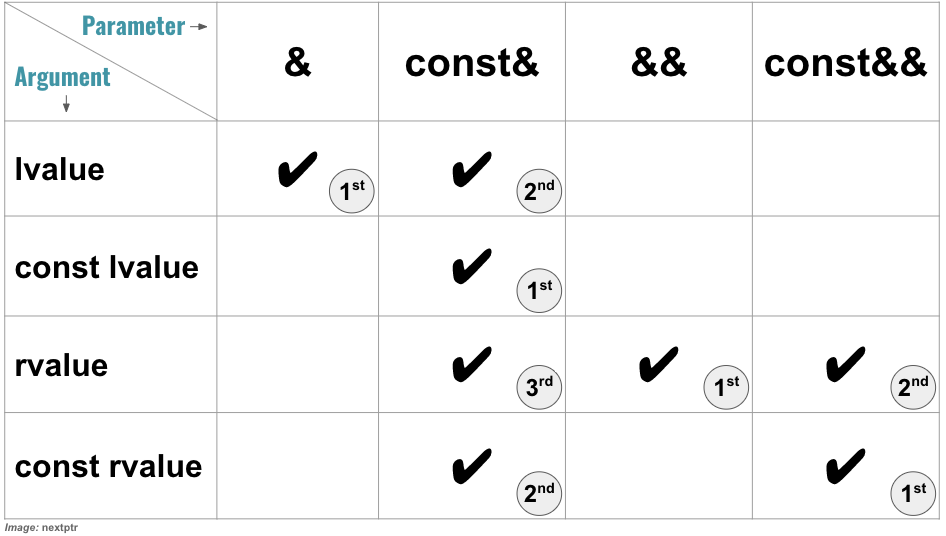Unintentionally using std::move on a const lvalue will result in a copy where a move is intended.

With all due respect to its virtues, IMO, the move semantics is easily one of the most complicated subjects to grasp in C++.
In this article, we are presenting one of those situations where std::move is misapplied. Suppose, Blob (shown below) is a class that holds some data, and a copy-constructor, a move-constructor, a copy-assignment-operator, and a move-assignment-operator are customarily implemented for it:
class Blob {
public:
Blob() = default;
Blob(const Blob& rhs) {
// do copy
}
Blob(Blob&& rhs) {
//do move
}
//copy and move assignment operators..
//more methods ...
private:
// some data
};
A function foo (shown below) takes a const lvalue reference of Blob as a parameter for read-only processing of data:
void foo(const Blob& blob) {
// process blob
}
Someplace else in code, the foo is called, and the Blob argument is moved to an std::vector for storage:
// std::vector<Blob> v;
// Blob b;
foo(b);
// move to vector
v.push_back(std::move(b)); //moved
At some point, it is determined that the code that moves the Blob to the std::vector should be transferred to foo as well. So, the foo is changed to take an std::vector< Blob>& parameter, but the parameter blob is inadvertently left const:
// 'blob' is still const
void foo(const Blob& blob, std::vector<Blob>& v) {
// process blob
v.push_back(std::move(blob)); //copied
}
// now foo is called as
// std::vector<Blob> v;
// Blob b;
foo(b,v);
Everything works quietly as before, except that the Blob is no longer moved but is copied to the std::vector. The reason behind the copy as opposed to the move is that the parameter blob is const. To ensure that the blob is moved, the function foo should be fixed to take Blob& instead of const Blob&. But the question is, how can the const-ness of that lvalue interfere with the move mechanism?
The std::move guarantees to cast its parameter to an rvalue, but it does not alter the const-ness of the parameter. So, the outcome of applying std::move on a const Blob& is const Blob&&. In words, a const lvalue is cast into a const rvalue. However, an std::vector<T> does not have any push_back method that takes a const T&& parameter. These are all the two overloads of push_back method an std::vector<T> has:
//1. copy-constructor of T is called
void push_back(const T& t); //copies t to new element
//2. move-constructor of T is called
void push_back(T&& t); //moves t to new element
Therefore the compiler, to respect the const-ness of the argument, chooses the std::vector< Blob>::push_back(const Blob&) method, which in turn invokes the copy-constructor of Blob.
To dig into it a little bit more, consider the following table that summarizes which type of parameter binding - &, const&, &&, const&& - can be bound to which value category of argument - lvalue, const lvalue, rvalue, const rvalue:

Note that, more than one parameter binding type can be bound to a category of argument in well-defined preference order, shown as 1st or 2nd or 3rd in the table. As an example, the parameter binding & is preferred over the parameter binding const& for an lvalue argument. Following code shows some examples based on the above table:
void f1(std::string& s);
void f2(const std::string& s);
void f3(std::string&& s);
void f4(const std::string&& s);
std::string s("Hi"); //lvalue
const std::string cs("Hi"); //const lvalue
f1(s); //OK
f1(cs); //ERROR
f1(std::move(s)); //ERROR
f1(std::move(cs)); //ERROR
f2(s); // OK
f2(cs); //OK
f2(std::move(s)); //OK
f2(std::move(cs)); //OK
f3(s); //ERROR
f3(cs); //ERROR
f3(std::move(s)); //OK
f3(std::move(cs)); //ERROR
f4(s); //ERROR
f4(cs); //ERROR
f4(std::move(s)); //OK
f4(std::move(cs)); //OK
The most important takeaway from the above table is that the const& can be bound to lvalues and rvalues, which makes the const&& parameter pointless. For rvalues we have && parameter binding and for const rvalues we can use const& binding. That shows why we never see any functions taking const&&, and why the copy-constructor with const& parameter is invoked for the const rvalue result of the std::move above.
[[ Further Reading ]]